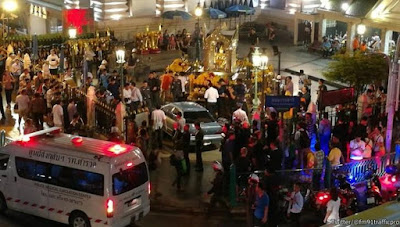With a little help from the creators of the
world-famous Amsterdam Light Festival, downtown Bangkok serves up a
buffet of illuminations

Ratchaprasong, Bangkok's famous shopping strip, is well known for its
annual festive lights that usually stretch from Siam Square up towards
Chidlom.
This year the area is brighter than ever thanks to "Thailand Kingdom of
Light II", an extravagant showcase of millions of lights plus
world-class light art from the Amsterdam Light Festival.
The dazzling festival, which has as its theme "Thai's Enlightening
Moments", is divided into five zones. The sacred Brahma shrine at the
Ratchaprasong intersection has become a "Lighting Pavilion" to welcome
visitors who come to pay their respects to Brahma and pray at the
shrine. The Ratchaprasong Skywalk has morphed into tunnels of light and
dubbed "Skywalk - The Garden of Light" under the concept "Fah Ngam Thee
Plai Roong" ("Beautiful Sky at the End of the Rainbow"). The area
beneath the Skywalk zone is decorated with a dazzling mesh of lights
with a giant digital clock on the façade of CentralWorld. Now showing
Thai numerals, the timepiece will change to Roman numerals on New Year's
Eve so everybody can count down together.
The last zone is the International Zone and showcases world-class light
art from Amsterdam Light Festival as well as collaborative masterpieces
created by world-renowned lighting designers and their Thai peers.

"The light festival in Bangkok features works that have come about from
the sharing of expertise between world-renowned lighting designer Rogier
van der Heide, who's the artistic director of the Amsterdam Light
Festival, and Thai lighting designers, educators, computer researchers
and developers from ESIC LAB, the Edutainment & Socio-Interaction
Computing Research Group," says Thailand Convention and Exhibition
Bureau president Nopparat Maythaveekulchai.
"Together they have created masterpieces in the International Zone with
the aiming of raising light festivals in Thailand to international
standards."
The International Zone exhibits eight artworks selected by van der
Heide, who is also a professor at the Technical University of Graz in
Austria.
"We have installed eight artworks: three of them are from the Amsterdam
Festival of Light and five have been newly made in cooperation with
students here in Bangkok," van der Heide tells Explore.
"These works are very international and they promote knowledge exchange
and innovation because we work with students on sophisticated
technology and computer programming. I think it is a great initiative.
For the visitors, the event creates a wonderful line up of artwork that
is interesting to see. It demonstrates light as a universal language
that can be understood all over the world.
"Ratchaprasong is a very busy area so a lot of people can come and see
these works. Our aim is make people smile when they see the lights. The
artists would like to show how important friendship and laughter are.
Instead of doing it in their own languages, they do it with lights,
which is basically understood by everybody. Light is a very great way to
bring people together and unite them around something positive," he
continues.
"I help to choose the artworks that are relevant to the location. The
artists have to radiate the positive message to the public and they have
to be imaginative. One of the criteria is their artworks should be
understandable to everyone. Some works like 'Floating Light' are quite
abstract but people can interact with the art and use their own
imagination while they make the light tube 'dance'. I like it because it
helps you make a connection with the art."
Van der Heide adds that to him, light creations are both art and
science. "Lighting is very artistic and there are lots of stories about
light. We have those 50 origami elephants that people like. The elephant
is the symbol of Thailand; it is ancient and traditional. What the
students put in there is sophisticated technology. We use laser cutting
and drawing with 3D software in the computer. We bring together two
worlds that are totally different and make it easy to understand.
"The heart-shaped work '195 Bottles, 1 Message' by Dutch artists Saskia
Hoogendoorn and Lieuwe Martijn is made of 195 bottles with LED lights
representing 195 countries in the world and the one message is that
there is only one religion that is really important to this world -
love," Rogier says.
The famous light designer admits with a rueful grin that in sleepless
areas like Ratchaprasong, installing light art is hard but adds that LED
technology makes it possible.
"It is very true that you cannot make light if there is no darkness.
That is the basic concept in architecture. But LED technology gives us
greater flexibility in creating light sculptures even in places that are
not so dark.
"In the past, lighting technology was quite expensive and very
difficult to install. You needed electricians, high voltage power, and
it would be very hot. Now with LED, everyone can make a light sculpture.
It is easy, flexible, affordable and it uses low power like batteries.
You can use your smartphone to control it. Just download the app and you
can control your LED lights.
Light is everything to van der Heide who used to look after the lighting for ballets and operas.
"The more I worked with electrical light, the more I became interested
in the real light like the light from the sun. I wanted to know how it
worked, how it touches us, emotionally and physically. There are so many
things in our body that are regulated by light, like our biorhythms and
our sleep. I feel very thankful for every morning even though I know
that tomorrow the sun will always come up.
"Light has a long history in all cultures. It is something that never
gets boring. I teach it at the university and there is always something
new. When you teach, the students will always come up with some new
questions and I think it is very interesting."
"We started working on the International Zone in September and in only
two months we have these amazing artworks. It would be great to start
working on the project earlier next year to engage the artists, the
engineers and technicians so we can work together and exchange our
knowledge and make better artworks. We would be a platform for these
talents. Next year we will attract more artists and work with more
universities and that will draw more partners," Rogier concludes.
Source: The Nation
*****
For the Best #Hotels and #Resorts
We help you with your #Bookings
.
.





























